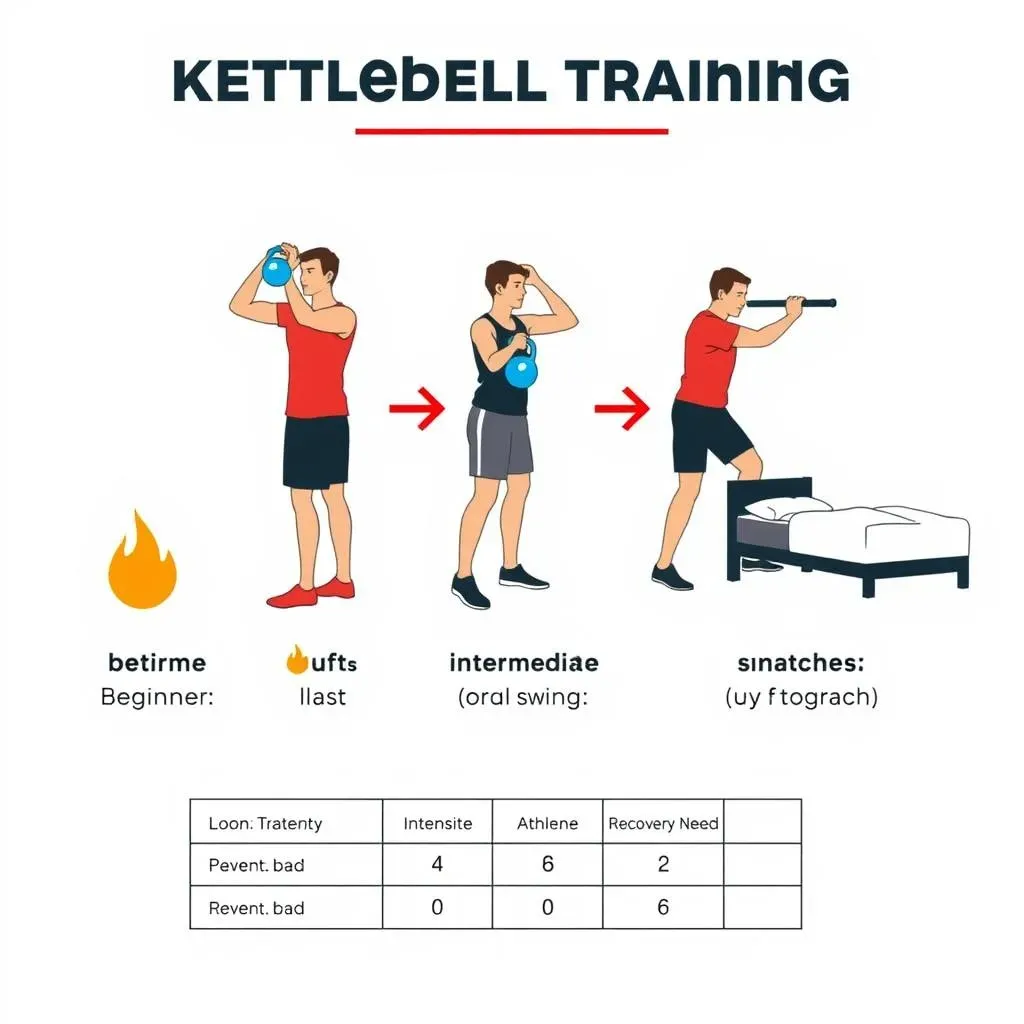Table of Contents
Ever wondered how many times a week you should be swinging that kettlebell? You're not alone. Figuring out how often should you do a kettlebell workout is a common question, and the answer isn't always straightforward. It's not about blindly following a one-size-fits-all plan; it's about understanding your body, your goals, and how kettlebells fit into your overall fitness picture. This article will break down the key factors that influence your ideal kettlebell workout frequency, from your experience level and recovery abilities to the intensity of your workouts and any other training you're doing. We'll explore sample workout schedules, discuss the importance of listening to your body, and provide tips for integrating kettlebell training seamlessly into your existing routine. So, whether you're a seasoned kettlebell enthusiast or just starting out, get ready to discover the sweet spot for your kettlebell workouts and unlock your full potential.
Understanding the Benefits of Kettlebell Workouts

Understanding the Benefits of Kettlebell Workouts
Full-Body Engagement and Functional Strength
Kettlebells aren't your average dumbbells. They force your body to work as a unit, engaging multiple muscle groups simultaneously. Think about a kettlebell swing – it's not just your arms doing the work. Your glutes, core, back, and legs are all firing to control the movement and generate power. This translates to functional strength, meaning the strength you build is directly applicable to real-life activities, whether it's lifting groceries, carrying kids, or just moving with more ease and efficiency.
It's like this: traditional weightlifting often isolates muscles. Kettlebells, on the other hand, integrate them. You’re not just building muscle; you’re building coordination, balance, and power – all at the same time.
Cardiovascular Fitness and Endurance
Don't let the strength-training aspect fool you; kettlebell workouts can seriously elevate your heart rate. The dynamic, compound movements involved in exercises like swings, snatches, and cleans demand a lot from your cardiovascular system. This means you're not only building strength but also improving your endurance and burning calories. It's a two-for-one deal.
Forget spending hours on the treadmill. A well-structured kettlebell workout can provide a challenging and effective cardio session, all while building strength and improving your overall fitness. It's about working smarter, not harder.
Improved Mobility, Stability, and Core Strength
Kettlebell training isn't just about lifting heavy things. Many kettlebell exercises require a significant range of motion, which can improve your mobility and flexibility over time. The offset load of the kettlebell also challenges your stability, forcing your core to work harder to maintain balance and control. This leads to improved core strength and stability, which is essential for everything from preventing injuries to improving posture.
Consider the Turkish Get-Up – it's a masterclass in mobility, stability, and core control. Or even a simple goblet squat forces you to engage your core to maintain an upright posture. These are just a couple of examples of how kettlebells can enhance these crucial aspects of fitness.
Factors Influencing How Often You Should Do a Kettlebell Workout

Factors Influencing How Often You Should Do a Kettlebell Workout
Experience Level and Current Fitness
Are you a kettlebell newbie or a seasoned pro? Your experience level plays a huge role in determining how often you should train. If you're just starting out, your body needs time to adapt to the unique demands of kettlebell training. Jumping into daily, high-intensity workouts is a recipe for soreness, injury, and burnout. Start slow, focus on mastering the fundamental movements, and gradually increase your training frequency as your body gets stronger and more resilient.
Think of it like learning a new language. You wouldn't try to write a novel on day one, right? You'd start with the basics – vocabulary, grammar, simple sentences. Kettlebell training is the same. Build a solid foundation before pushing yourself too hard. A good starting point might be 2-3 sessions per week, with plenty of rest in between.
Workout Intensity and Volume
Not all kettlebell workouts are created equal. A light, technique-focused session is far less taxing than a high-volume, high-intensity grinder. If you're pushing yourself to the limit in every workout, your body will need more time to recover. Overtraining can lead to fatigue, decreased performance, and an increased risk of injury. Pay attention to your body's signals and adjust your training frequency accordingly.
Consider this: a week of heavy swings, snatches, and Turkish Get-Ups will require more recovery time than a week of lighter goblet squats and rows. Varying the intensity and volume of your workouts can help you avoid overtraining and stay fresh. You might alternate between high-intensity days and low-intensity days, or implement deload weeks where you reduce your training volume to allow your body to fully recover.
Factor | Low Frequency (1-2x/week) | Moderate Frequency (3-4x/week) | High Frequency (5+x/week) |
|---|---|---|---|
Experience Level | Beginner | Intermediate | Advanced |
Workout Intensity | Low to Moderate | Moderate to High | High |
Recovery Needs | High | Moderate | Low (Requires careful planning) |
Sample Kettlebell Workout Schedules: Finding Your Rhythm

Sample Kettlebell Workout Schedules: Finding Your Rhythm
Alright, so you've got the benefits down and you're aware of the factors influencing your training. Now, let's talk about putting it all together. Finding your rhythm with kettlebell workouts is about experimenting and discovering what works best for you. Here are a few sample schedules to get you started, but remember, these are just templates. Feel free to adjust them based on your individual needs and preferences.
Kettlebell Workout: Listen to Your Body and Adjust Accordingly

Kettlebell Workout: Listen to Your Body and Adjust Accordingly
This is where the rubber meets the road, folks. All the schedules and advice in the world won't matter if you're not tuning into your body's signals. Kettlebell Workout: Listen to Your Body and Adjust Accordingly. Are you feeling energized and ready to crush your workout, or are you dragging and sore? Don't be afraid to modify your plan based on how you're feeling on any given day. This might mean reducing the weight, shortening the workout, or even taking a rest day. There's no shame in backing off when your body needs it. In fact, it's a sign of intelligence and maturity as an athlete.
Think of your body as a finely tuned instrument. It's constantly providing you with feedback, but you need to be able to interpret it. Learn to differentiate between normal muscle soreness and pain that could indicate an injury. Pay attention to your energy levels, sleep quality, and overall mood. These are all important indicators of how well you're recovering and adapting to your training. If you're consistently feeling run down or experiencing nagging aches and pains, it's time to reassess your approach.
Here's a quick guide to help you decipher what your body might be trying to tell you:
- Muscle Soreness (DOMS): This is normal after a challenging workout, especially when you're trying new exercises. It usually peaks 24-72 hours after training and gradually subsides.
- Joint Pain: This could indicate an injury or overuse. Don't ignore it! Rest, ice, and consider seeing a physical therapist.
- Fatigue: Feeling tired is normal, but chronic fatigue could be a sign of overtraining. Make sure you're getting enough sleep and nutrition.
- Decreased Performance: If you're consistently getting weaker or slower, it's time to back off and prioritize recovery.
- Mood Changes: Overtraining can affect your mood and make you more irritable or anxious. Listen to your brain as well as your body.
Combining Kettlebell Training with Other Activities

Combining Kettlebell Training with Other Activities
So, you're digging the kettlebell life, but you've also got a soft spot for other activities? Awesome! Combining Kettlebell Training with Other Activities can be a fantastic way to create a well-rounded fitness routine. However, it's important to approach it strategically to avoid overtraining and maximize your results. Think about it like mixing ingredients for a recipe – you want to create a delicious dish, not a culinary disaster. The key is understanding how different activities complement each other and how to structure your training to allow for adequate recovery.
For example, if you're a runner, kettlebells can be a great way to build strength and stability, which can improve your running performance and reduce your risk of injury. Focus on exercises that strengthen your glutes, hamstrings, and core, like swings, deadlifts, and squats. Just be mindful of the impact on your legs and adjust your kettlebell training accordingly, especially before or after long runs. Similarly, if you're into yoga, kettlebells can help you build strength and power, which can enhance your flexibility and balance. Exercises like Turkish Get-Ups and windmills can be particularly beneficial for improving your overall body awareness and control. The possibilities are endless, but careful planning is essential.
Here are some tips for successfully combining kettlebell training with other activities:
- Prioritize Recovery: This is the most important factor. Make sure you're getting enough sleep, nutrition, and rest to allow your body to recover from your workouts.
- Listen to Your Body: Don't be afraid to modify your training plan based on how you're feeling. If you're sore or fatigued, take a rest day or reduce the intensity of your workout.
- Structure Your Training: Plan your workouts in advance and consider how different activities will affect each other. Avoid scheduling two high-intensity workouts on the same day.
- Focus on Complementary Activities: Choose activities that complement each other and address different aspects of fitness. For example, combine kettlebell training with running, yoga, or swimming.
- Be Patient: It takes time to adapt to a new training routine. Don't get discouraged if you don't see results immediately. Stick with it, and you'll eventually reap the rewards.
Conclusion: Finding Your Kettlebell Sweet Spot
Ultimately, determining how often should you do a kettlebell workout comes down to a personalized approach. There's no magic number that works for everyone. By considering the factors we've discussed—your fitness level, recovery capacity, workout intensity, and overall training schedule—you can create a sustainable and effective kettlebell routine. Listen to your body, be patient with the process, and don't be afraid to experiment. The key is to find a frequency that challenges you without leading to burnout or injury. With consistent effort and mindful adjustments, you'll be well on your way to reaping the many benefits of kettlebell training.